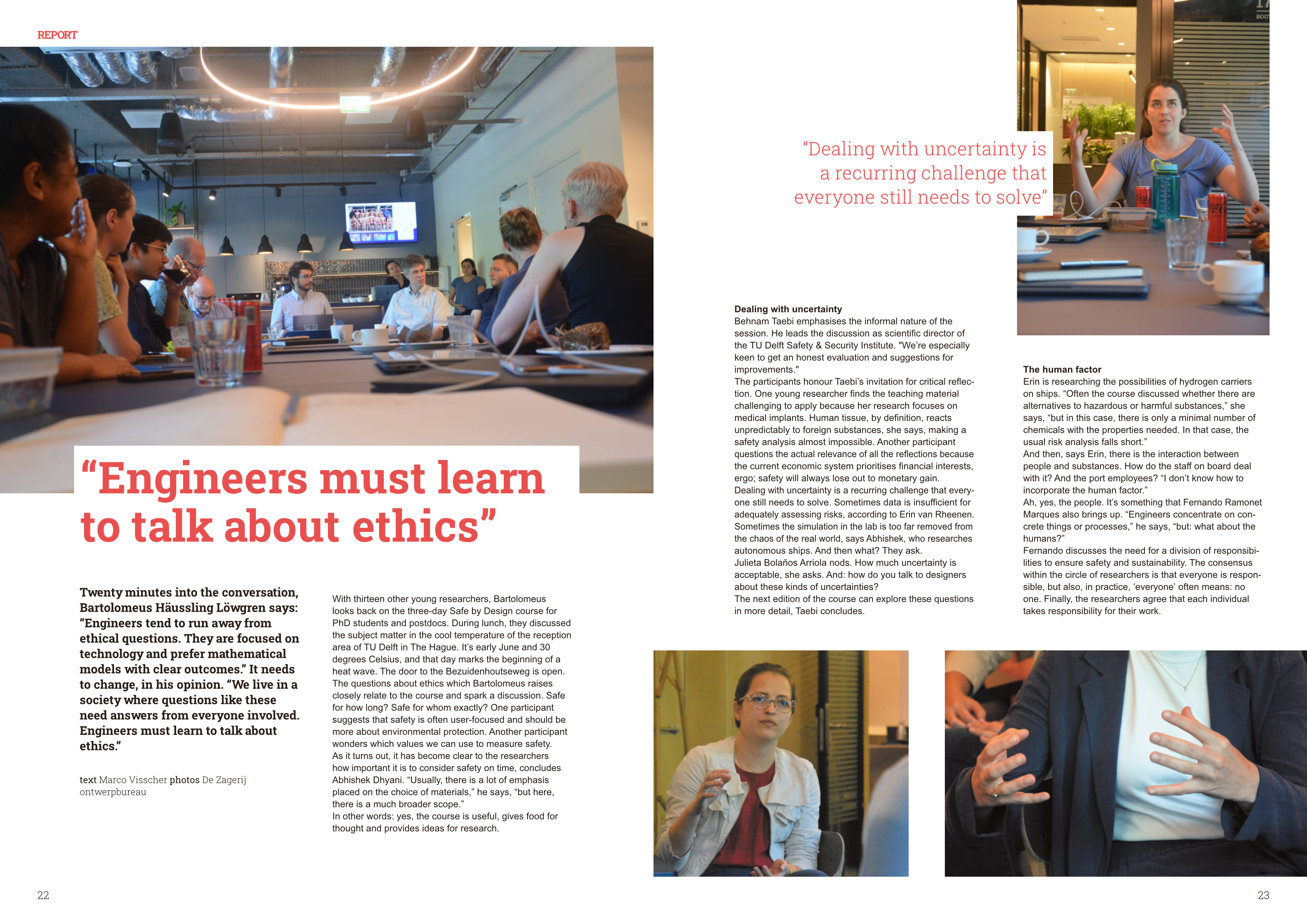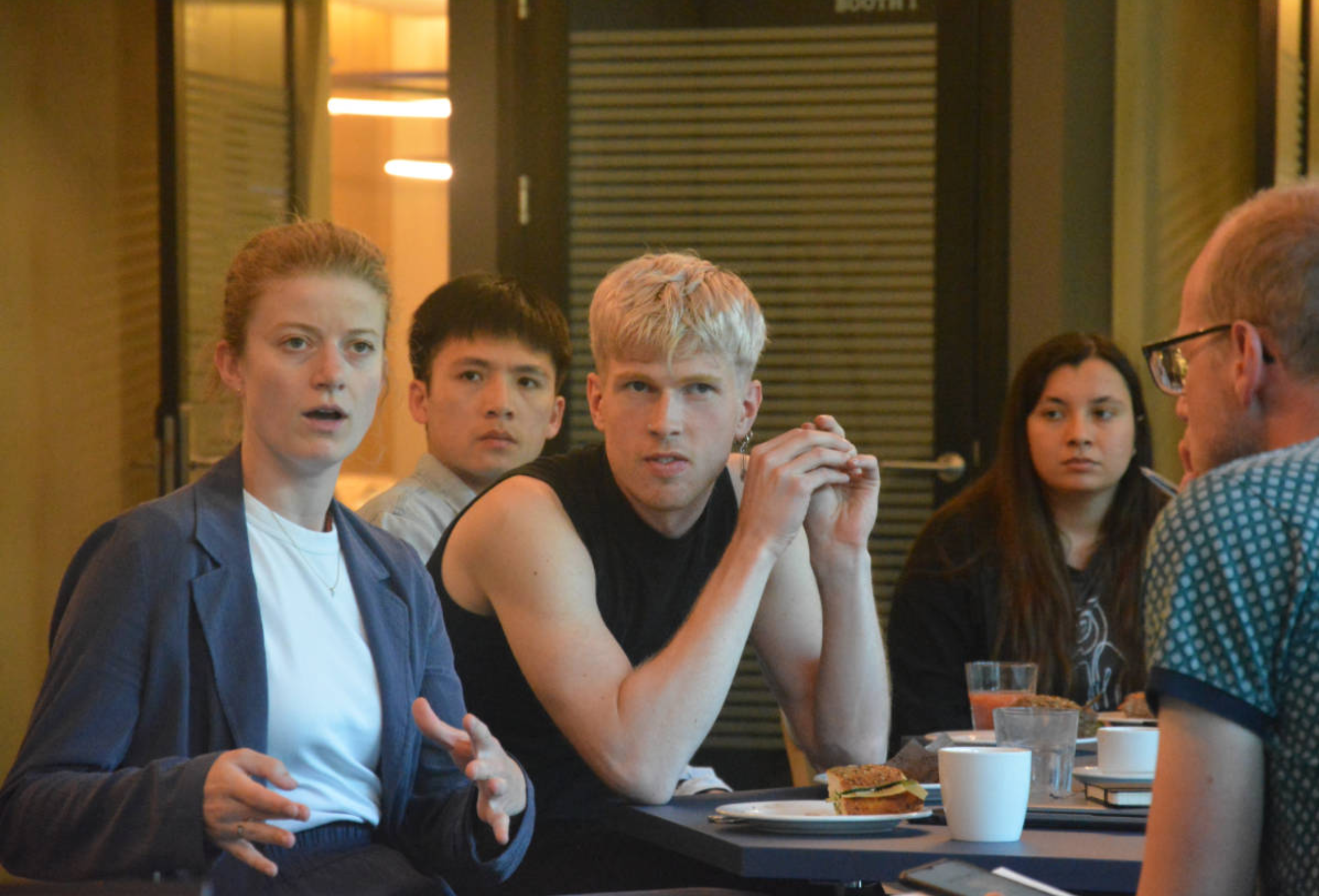‘'Engineers must learn to talk about ethics”
Young researchers reflect on learnings during the three-day Safe by Design course
Twenty minutes into the conversation, Bartolomeus Häussling Löwgren says: “Engineers tend to run away from ethical questions. They are focused on technology and prefer mathematical models with clear outcomes.” It needs to change, in his opinion. “We live in a society where questions like these need answers from everyone involved. Engineers must learn to talk about ethics.”
text Marco Visscher photos De Zagerij ontwerpbureau
With thirteen other young researchers, Bartolomeus looks back on the three-day Safe by Design course for PhD students and postdocs. During lunch, they discussed the subject matter in the cool temperature of the reception area of TU Delft in The Hague. It’s early June and 30 degrees Celsius, and that day marks the beginning of a heat wave. The door to the Bezuidenhoutseweg is open. The questions about ethics which Bartolomeus raises closely relate to the course and spark a discussion. Safe for how long? Safe for whom exactly? One participant suggests that safety is often user-focused and should be more about environmental protection. Another participant wonders which values we can use to measure safety. As it turns out, it has become clear to the researchers how important it is to consider safety on time, concludes Abhishek Dhyani. “Usually, there is a lot of emphasis placed on the choice of materials,” he says, “but here, there is a much broader scope.”
In other words: yes, the course is useful, gives food for thought and provides ideas for research.
Dealing with uncertainty
Behnam Taebi emphasises the informal nature of the session. He leads the discussion as scientific director of the TU Delft Safety & Security Institute. "We’re especially keen to get an honest evaluation and suggestions for improvements."
The participants honour Taebi’s invitation for critical reflection. One young researcher finds the teaching material challenging to apply because her research focuses on medical implants. Human tissue, by definition, reacts unpredictably to foreign substances, she says, making a safety analysis almost impossible. Another participant questions the actual relevance of all the reflections because the current economic system prioritises financial interests, ergo; safety will always lose out to monetary gain.
Dealing with uncertainty is a recurring challenge that everyone still needs to solve. Sometimes data is insufficient for adequately assessing risks, according to Erin van Rheenen. Sometimes the simulation in the lab is too far removed from the chaos of the real world, says Abhishek, who researches autonomous ships. And then what? They ask.
Julieta Bolaños Arriola nods. How much uncertainty is acceptable, she asks. And: how do you talk to designers about these kinds of uncertainties?
The next edition of the course can explore these questions in more detail, Taebi concludes.
The human factor
Erin is researching the possibilities of hydrogen carriers on ships. “Often the course discussed whether there are alternatives to hazardous or harmful substances,” she says, “but in this case, there is only a minimal number of chemicals with the properties needed. In that case, the usual risk analysis falls short.”
And then, says Erin, there is the interaction between people and substances. How do the staff on board deal with it? And the port employees? “I don’t know how to incorporate the human factor.”
Ah, yes, the people. It’s something that Fernando Ramonet Marques also brings up. “Engineers concentrate on concrete things or processes,” he says, “but: what about the humans?” Fernando discusses the need for a division of responsibilities to ensure safety and sustainability. The consensus within the circle of researchers is that everyone is responsible, but also, in practice, ‘everyone’ often means: no one. Finally, the researchers agree that each individual takes responsibility for their work.
The consensus is that everyone is responsible, but also, in practice, ‘everyone’ often means: no one
Taebi adds that in recent years, safety has been a theme that concerns more and more people. Initially, car designers mainly focussed on the safety of the occupants. Later, they considered the safety of those in the other car involved in a possible collision. Nowadays, they also take cyclists and pedestrians into account more than ever.
At the other end of the process, there may be an element of tunnel vision for the end user. For example, if there is confusion about the safety of new technology. “Our perception of security depends on our knowledge,” says Shachi Shanbhag. “Engineers might understand new technology, but the general public can still misunderstand it. For some, the technical jargon is simply incomprehensible. As a result, the technology might be perfectly safe but regarded as unsafe by an uninformed public.”
Shachi’s comment prompts reflection on whether it matters if you design for actual safety or just the perception of safety. Perhaps, someone suggests, in this respect, it is a good step that the United Nations International Maritime Organization (IMO) is making a switch from precise regulations (with minimum dimensions of a door, for example) to more general goal-based standards (the door must be safe). "It’s more difficult to work with, but it challenges engineers to explain safety better."
Interest in repair
The young researchers are visibly involved in such theoretical reflections and show a far-reaching interest in sustainability. Julieta is researching the possibilities of a so-called circular economy, in which, for example, new raw materials are reduced, and waste is reused in a closed cycle. “The circular economy is radically different from the linear economy,” says Julieta, “because there are currently no financial incentives to repair and recycle, for example, due to cheap production.” She has noticed that conversations about the circular transition attract civil servants, entrepreneurs and social organisations. Engineers remain on the sidelines for now, despite “the adaptation to a system with multiple life cycles and an emphasis on repair having consequences for design and safety”, according to Julieta.
Taebi challenges her to be more concrete in her argument. “Many products are not designed for home repairs,” explains Julieta. “Manufacturers claim it’s due to regulations and legislation that instruct them to protect the safety of their customers. And indeed, that’s a legitimate point. A broken coffee machine means a combination of electricity, water and chemicals. Is that combination dangerous? Does everyone understand that you must first pull the plug out of the socket? Is everyone capable of doing repairs themselves?”
In any case, a better emphasis on recovery rather than production is called for, Evelien Scheffers adds. To illustrate this, she refers to her department at TU Delft called Ship Design, Production & Operation. Is there really no room for the word Repair in that title?”
In twenty years
The evaluation ends with an open question: where do you hope the Safe (& Sustainable) by Design field will be in about twenty years? “A world without accidents,” jokes Anna Flavia de Souza Silva. “Universal standards,” suggests Stratos Mikropoulos. Abhishek describes a kind of global handbook for safety.
Evelien has an entirely different picture of the ideal future. She hopes the field will no longer exist. She explains, “It means that ideas about safety and sustainability would be fully integrated into design processes and no longer have
to be offered separately.
Safe by design
A clean and safe world. Safe products, materials and processes, without risks for people and the environment. Now, later, and in the far future. We achieve this by considering safety from the very beginning of every product and process development. In collaboration with TU Delft, among others, the Ministry of Infrastructure and Water Management is shaping the Safe by Design approach and policy through joint research and innovation. Research topics do not only concern materials, chemicals and products, but also cover ethics and awareness.
Read more
Research paper 'Safe-by-design in engineering: An overview and comparative analysis of engineering disciplines' by a group of TUD researchers
About this course
The TU Delft Safety & Security Institute runs an annual 3-day interdisciplinary course Safe by Design (SbD). Sustainability is also included, or S(S)bD. This approach shifts our focus on safety into the earliest stages of design and extends it by considering safety alongside other
essential values. The design and implementation of the course is a collaboration between TU Delft, Wageningen University & Research, Utrecht University and RIVM. The course is open to young researchers (PhD students and postdocs) from Dutch universities.


